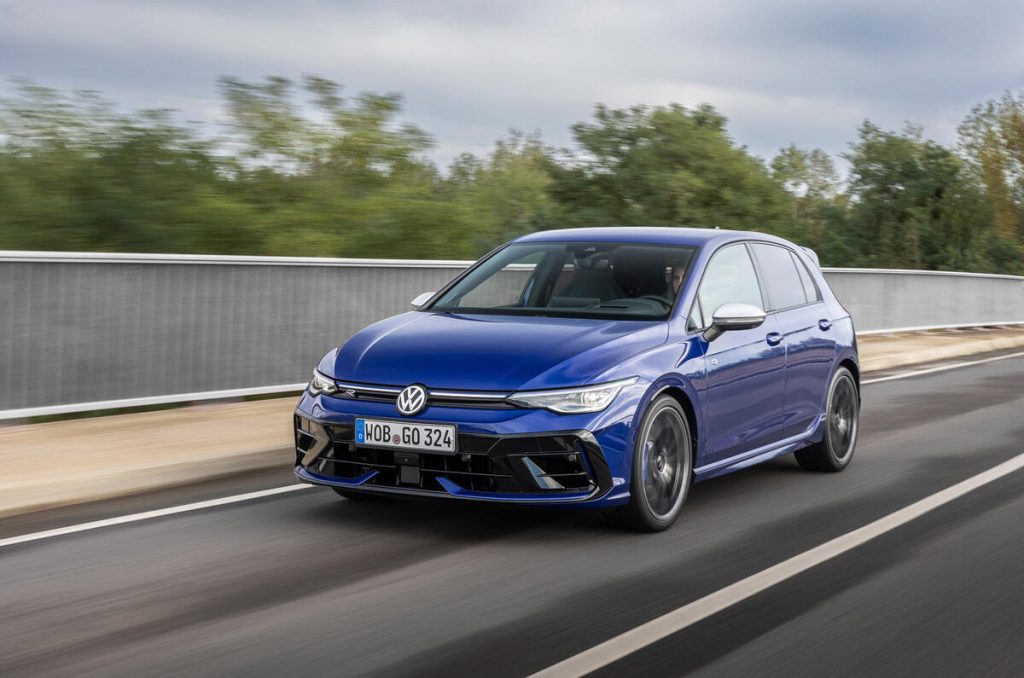Under the bonnet, the turbocharged 2.0-litre engine now kicks out an added 8bhp at 328bhp. Torque remains the same as before at 310lb ft, but it is now developed on a 150rpm wider range of revs between 2100rpm and 5500rpm. In a bid to imbue it with added character while retaining the linear properties for which it is renowned, the operation of the turbocharger has been revised. It now spins faster on a trailing throttle to ensure greater response when you get back on the power. The throttle valve is also kept open on the overrun, mimicking the properties of an anti-lag system. It is all fed through a reworked version of Volkswagen’s in-house-produced seven-speed dual-clutch automatic gearbox and a modified 4Motion four-wheel drive system with revised electronic torque splitter to vary the amount of drive sent to each individual rear wheel. The exterior design changes are predictably subtle, starting with a new-look front bumper with larger ducts for more effective cooling of the front brakes and engine bay, as well as a more prominent splitter for added downforce at speed. There’s also a larger tailgate-mounted spoiler and a reworked diffuser to better manage the airflow and downforce. It is understated in a typical Volkswagen way, but with a fittingly sporting stance that benefits greatly from a 20mm-lower ride height and wider tracks than milder Volkswagen Golf models. Setting it all off is a new range of wheels, including the new optional forged aluminium Warmenau items worn by our test car, which weigh 20% less than the standard 18in Jerez wheels at just 8kg. Inside, the 2025-model-year Golf R benefits from many of the same changes as lesser Golf models. Central to these is a new touchscreen infotainment display, which is larger than before, at 12.9in in diameter instead of the previous 10.2in. The home screen is now customisable, while the controls for the air ventilation and seat heaters are now permanently displayed in the lower section as part of a comprehensive reworking of the user interface. The slider touch bar to regulate the volume and temperature remains, but it now features backlighting. It is all supported by a new software package that forms part of Volkswagen’s MIB4 multimedia system. It provides added response as you scroll through the menus and more intuitive commands, making the new Golf R more satisfying to operate than the model it replaces. With wireless operation for Android Auto and Apple CarPlay and a wireless charging pad, the digital interface is well up to the standards of the hot hatch competition. There’s one curious exception, though: unlike other facelifted Golf models, the R retains the capacitive steering wheel controls but with greater pressure required to engage them. The reason stems from the unique control layout, which provides an R control to directly switch into Race mode. On the road, the Golf R feels more spirited than the model it replaces. There’s greater response at all points. It picks up eagerly, is impressively strong across the mid-range and, with peak torque extending higher than before, it has got more determined at the top end. It’s all accompanied by an alluringly raspy exhaust note in combination with a revised sound synthesiser and the optional (and expensive) Akrapovic titanium exhaust. The brakes, too, are up to snuff. With ventilated 357mm front and 310mm rear discs, there is strong stopping ability even after repeated blows at the end of the Lausitzring’s long straight. Excellent pedal feel is another plus point, providing the driver with confidence when wiping off speed in a hurry. The team behind the chassis tuning of both the new Golf GTI and Golf R is headed by Florian Umbach, who previously held the same position at Bugatti, where he was responsible for the Veyron and Chiron. He says the goal with the new model was to provide it with added feel and feedback and a generally more engaging and more dynamic driving experience. The steering remains a central element to the Golf R’s character, with tactile properties and an agreeably linear build-up in weighting. It is backed up by excellent body control with progressive movements that keep the driver well aware of the limits. The changes to the four-wheel drive system and newly calibrated torque splitter, which Umbach describes as being “softened”, work together with subtler torque vectoring by braking to bring greater fluidity to the handling. The balance is more neutral, too, and unleashing power in Race mode on a circuit sees most of the drive shifted to the outside rear wheel to nix any understeer. There is outstanding purchase and grip from the optional 235/35 R19 Bridgestone Potenza Race tyres. The Golf R rides well for a car with such a clear sporting brief. It is firmer than the Golf GTI. But with optional adaptive damping as part of a standard Dynamic Chassis Control (DCC) package, it offers impressive compliance even on the low-profile rubber.











